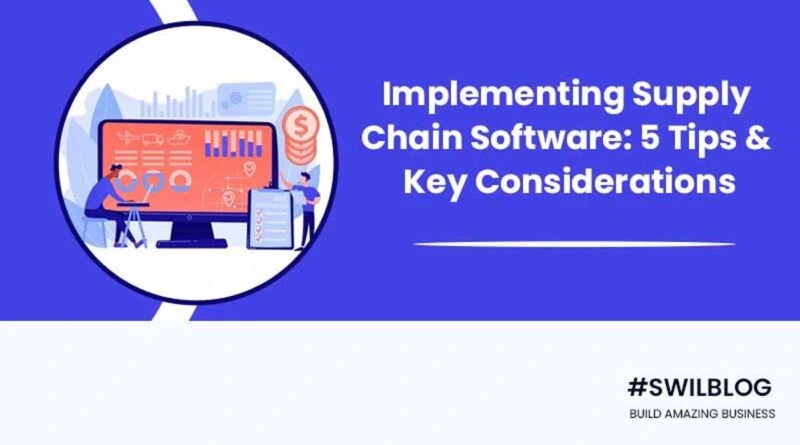Businesses are in the bid to digitize their supply chain management. You need to keep up with the times to gain a competitive edge in the market.
How? Invest in the top supply chain management software to improve your business operations.
But introducing a new supply chain management system into your operations can be costly and complex.
First, you must plan carefully before pushing through with its implementation. Otherwise, you won’t maximize the benefits of supply chain management despite the new technology.
Index..
- Why is supply chain management important?
- What are the benefits of supply chain management software?
- What to consider during implementation?
- Future of supply chain management
Why is supply chain management important?

Supply chain management involves the flow of goods and services within your business. This includes the procurement of raw materials up until the production of finished products.
In fact, 96% of companies with efficient supply chain management achieve better financial and operations results.
Having an efficient supply chain management:
- Reduces operating costs,
- Speeds up product flows to customers,
- Allows you to establish strong communication and relationships with suppliers, and
- Ensures the successful delivery of services to your customers
To enhance your business performance, focus on creating an efficient supply chain management.
This is where supply chain management software comes in.
What are the benefits of supply chain management software?
It is tough to keep track of the countless processes and stages of your supply chain, especially if you plan to do it manually. But thanks to digital technology, the task is easier and more accessible than ever.
One of the biggest benefits of a supply chain management software is its automation tools. It offloads repetitive and menial tasks from your employees such as:
- Managing paperwork
- Keeping track deliveries
- Restocking inventory
- Accepting and managing orders
- Managing warehouse
As a result, employees get more time to focus on fostering lasting relationships with suppliers and customers.
Aside from automation, the software increases visibility in your supply chain. It monitors the various processes in your operations and provides you with real-time information about your products. This also boosts engagement within your internal operations and your suppliers.
Through accessible data, the various stakeholders can become more involved in the process.
Because of these, the demand for supply chain management software will reach $17.218 billion in 2021.
What to consider during implementation?
1. Identify specific needs in your supply chain
Choosing the right supply chain management software can be tough. If you don’t know what to look out for, you might end up with a software that will not meet your business’ needs. Hence, you must first review your current supply chain operations before introducing a new system to it.
Reviewing your current supply chain helps you identify:
- What are the bottlenecks in your workflows?
- What are the challenges that your supply chain operators are facing?
- Which areas can you improve on?
Knowing your supply chain’s demands gives you an idea of what type of software you need. For example, you are running an online business. You will need a supply chain software that you can link to your ecommerce platforms like Amazon.
Other things you need to answer include:
- How big is your supply chain operation?
- What industry are you in?
- What types of supply chain management do you have?
- How skillful are your employees when it comes to new technology?
- How many suppliers or vendors are you working with?
2. Onboard users into the new system
Your employees need time to adjust to the new technology. But not everyone can be tech-savvy enough to do it on their own.
The key to a successful implementation is onboarding all users. This includes not only your supply chain operators but also your suppliers and other partners.
Training sessions are important during onboarding to teach users about the basics of the software – how to use it, how to log in, and more. It can also be in a seminar where you discuss the purpose behind the software’s implementation.
Likewise, you can present your implementation plan to them to know what changes to expect during the transition phase.
You can also check which supply chain management software providers offer demo sessions, training, or seminars. This way, you won’t have to worry about onboarding yourself.
Some even provide comprehensive documentation that users can use as reference.

3. Leverage the right technology
Another key consideration is the technology you need for supply chain management software. This refers to:
- What specifications do you need for your hardware?
- How many servers do you need?
- What development stack would it be built on?
- Will you choose an on-premise or SaaS product?
- Will you be using in-house or outsourcing the development?
Answering these questions will determine if your operation is ready for the new software or not. Without the right technology to support your system, you can’t maximize the different supply chain management software features.
Consider creating a checklist of what you will need for the implementation.
It can also be a step-by-step account of how you will introduce the software into your operations. This way, you won’t skip an important step in the implementation process.
4. Gauge software integration compatibility
Creating a seamless digital experience for your operations can be challenging, especially if you are using several software solutions at once. Avoid disruptive workflows by integrating your software together.
This is another key consideration when implementing a supply chain management software. You must ensure that it is compatible with the rest of your digital ecosystem.
There are many benefits to having an integrated system. For one, it automatically synchronizes data across all your platforms. This ensures that everyone deals with a single version of truth throughout. Likewise, it allows users to access tools from other solutions without switching tabs in the process.
Consider integrating your software to integrate with your supply chain management software with some of the top inventory management software platforms. You can also connect it to your ecommerce platform for your online business.
5. Continue monitoring and reviewing
Successful implementation doesn’t just happen overnight. It can take some time before you can finally see the results. So you must continue to monitor and review the new system upon its implementation. This allows you to measure its overall impact on your supply chain operation.
The best way to do that is to determine if you are profiting from your supply chain management software. Are you getting your buck’s worth after its implementation? Does maintaining the system add more to your expenses than reduce your operation cost?
Your users can also have something to say about the new system. Listening to their feedback will give you an idea of how the new system fits in with your supply chain workflows.
Future of supply chain management
Businesses are racing towards full digital transformation. To remain competitive, you must adopt an advanced supply chain system. What you need is the right supply chain management software for your business.
Nonetheless, implementation takes more than just choosing and installing the software. It requires extra steps to make sure that it goes smoothly.








